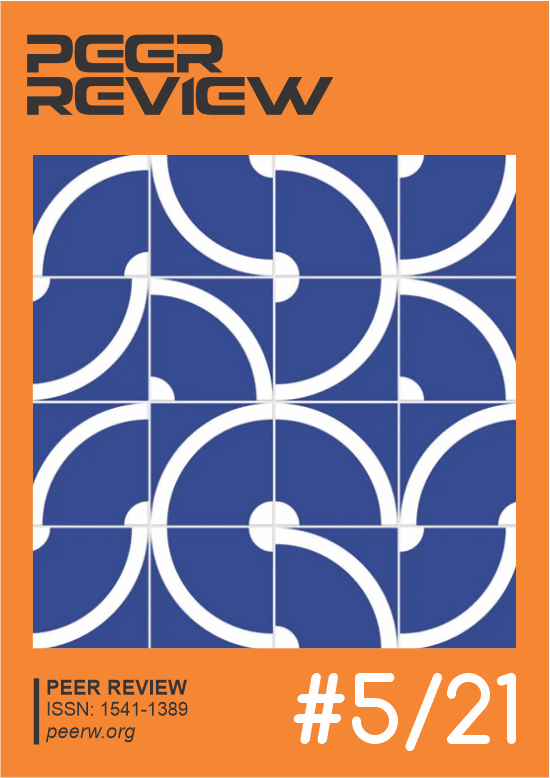Desenvolvimento de uma célula de manufatura aditiva robotizada baseada no processo deposição de metal à laser usando arame de soldagem
DOI:
https://doi.org/10.53660/1102.prw2664Palavras-chave:
Deposição de metal à laser, Gêmeo digital, ISO 23247, Manufatura aditivaResumo
Este trabalho apresenta a implementação de um Gêmeo Digital para uma célula de fabricação aditiva robotizada que utiliza o processo de Deposição de Metal a Laser com Arame (LMD-Wire). O sistema é composto por um cabeçote LMD-Wire da Meltio3D e um robô Kuka KR 70 R2100. Isso é especialmente relevante em tecnologias emergentes, como a fabricação LMD, que utiliza um laser de diodo para fundir seletivamente uma camada de material metálico alimentado por arame ou pó. Para desenvolver o Gêmeo Digital, é utilizada a ISO 23247 como referência e o ambiente CAD Rhinoceros-Grasshopper em conjunto com a plataforma de simulação Kuka.Sim, com o objetivo de criar uma plataforma CAD/CAPP/CAM para a célula robotizada.
Downloads
Referências
ALVARES, A.J. and LACROIX, I., 2023a. “CAD/CAPP/CAM with Grasshopper to Robotic Adittive Manufacture”. https://youtu.be/UsXkto9vljg. [Online; accessed 19-Juny-2023].
ALVARES, A.J. and LACROIX, I., 2023b. “Simulation with Kuka.Sim to Robotic Adittive Manufacture”. https://youtu.be/ukc_CrEFBRE. [Online; accessed 28-Juny-2023].
BIEGLER, M., GRAF, B. and RETHMEIER, M., 2018. “In-situ distortions in lmd additive manufacturing walls can be measured with digital image correlation and predicted using numerical simulations”. Additive Manufacturing, Vol. 20, p. 101 – 110. doi:10.1016/j.addma.2017.12.007.
CABRAL, J.V.A., GASCA, E.A.R. and ALVARES, A.J., 2023. “Digital twin implementation for machining center based on iso 23247 standard”. IEEE Latin America Transactions, Vol. 21, No. 5, pp. 628–635. doi:10.1109/TLA.2023.10130834.
CUEVAS, D. and PUGLIESE, G., 2020. Advanced 3D Printing with Grasshopper, Clay and FDM. Independently published. ISBN 9798635379011. URL https://books.google.com.br/books?id=2nGzzQEACAAJ.
FENG, A., CHEN, C., WU, C., WEI, Y. and WANG, Y., 2022. “Modeling of laser melting deposition equipment based on digital twin”. Metals, Vol. 12, No. 2. doi:10.3390/met12020169.
GARMENDIA, I., PUJANA, J., LAMIKIZ, A., MADARIETA, M. and LEUNDA, J., 2019. “Structured light-based height control for laser metal deposition”. Journal of Manufacturing Processes, Vol. 42, p. 20 – 27. doi:10.1016/j.jmapro.2019.04.018.
GLAESSGEN, E. and STARGEL, D., 2012. “The digital twin paradigm for future of NASA and U.S. air force vehicles”. In 53rd AIAA/ASME/ASCE/AHS/ASC Structures, Structural Dynamics and Materials Conference.
GU, H. and LI, L., 2019. “Computational fluid dynamic simulation of gravity and pressure effects in laser metal deposition for potential additive manufacturing in space”. International Journal of Heat and Mass Transfer, Vol. 140, p. 51 – 65. doi:10.1016/j.ijheatmasstransfer.2019.05.081.
HANKEL, M., 2015. “The reference architectural model industrie 4.0 (rami 4.0) - bosch rexroth”.
HUANG, Z., SHEN, Y., LI, J., FEY, M. and BRECHER, C., 2021. “A survey on ai-driven digital twins in industry 4.0: Smart manufacturing and advanced robotics”. Sensors, Vol. 21, No. 19. ISSN 1424-8220. doi:10.3390/s21196340.
ISO 23247-1, 2021. “Automation systems and integration — digital twin framework for manufacturing — part 1: Overview and general principles”.
JAN, Z., AHAMED, F., MAYER, W., PATEL, N., GROSSMANN, G., STUMPTNER, M. and KUUSK, A., 2023. “Artificial intelligence for industry 4.0: Systematic review of applications, challenges, and opportunities”. Expert Systems with Applications, Vol. 216. doi:10.1016/j.eswa.2022.119456.
KERIN, M., PHAM, D.T., HUANG, J. and HADALL, J., 2023. “A generic asset model for implementing product digital twins in smart remanufacturing”. The International Journal of Advanced Manufacturing Technology, Vol. 124, No. 9, pp. 3021–3038. doi:10.1007/s00170-022-09295-w. URL https://doi.org/10.1007/s00170-022-09295-w.
KUBOTA, T., HAMZEH, R. and XU, X., 2020. “Step-nc enabled machine tool digital twin”. Procedia CIRP, Vol. 93, pp. 1460– 1465. ISSN 2212-8271. doi:https://doi.org/10.1016/j.procir.2020.06.004. 53rd CIRP Conference on Manufacturing Systems 2020.
LETTORI, J., RAFFAELI, R., BILANCIA, P., PERUZZINI, M. and PELLICCIARI, M., 2022. “A review of geometry representation and processing methods for cartesian and multiaxial robot-based additive manufacturing”. The International Journal of Advanced Manufacturing Technology, Vol. 123, No. 11, pp. 3767–3794.
LIU, C., LE Roux, L., KÖRNER, C., TABASTE, O., LACAN, F. and BIGOT, S., 2022. “Digital twin-enabled collaborative data management for metal additive manufacturing systems”. Journal of Manufacturing Systems, Vol. 62, p. 857 – 874.
LIU, C., VENGAYIL, H., LU, Y. and XU, X., 2019. “A cyber-physical machine tools platform using opc ua and mtconnect”. Journal of Manufacturing Systems, Vol. 51, pp. 61–74. ISSN 0278-6125.
LU, Y., LIU, C., WANG, K.I.K., HUANG, H. and XU, X., 2020. “Digital twin-driven smart manufacturing: Connotation, reference model, applications and research issues”. Robotics and Computer-Integrated Manufacturing, Vol. 61, p. 101837. ISSN 0736-5845. doi:https://doi.org/10.1016/j.rcim.2019.101837.
LUO, W., HU, T., YE, Y., ZHANG, C. and WEI, Y., 2020. “A hybrid predictive maintenance approach for cnc machine tool driven by digital twin”. Robotics and Computer-Integrated Manufacturing, Vol. 65, p. 101974. ISSN 0736-5845. doi:https://doi.org/10.1016/j.rcim.2020.101974.
PIRES, J.N., AZAR, A.S., NOGUEIRA, F., ZHU, C.Y., BRANCO, R. and TANKOVA, T., 2022. “The role of robotics in additive manufacturing: review of the am processes and introduction of an intelligent system”. Vol. 49, No. 2, pp. 311–331. URL https://doi.org/10.1108/IR-06-2021-0110.
QIAO, Q., WANG, J., YE, L. and GAO, R.X., 2019. “Digital twin for machining tool condition prediction”. Procedia CIRP, Vol. 81, pp. 1388–1393. ISSN 2212-8271. 52nd CIRP Conference on Manufacturing Systems (CMS), Ljubljana, Slovenia, June 12-14, 2019.
SHAO, G. and HELU, M., 2020. “Framework for a digital twin in manufacturing: Scope and requirements”. Manufacturing Letters, Vol. 24, p. 105 – 107. doi:10.1016/j.mfglet.2020.04.004.
STEP Tools, I., 2016. “Digital Thread and Digital Twin Demonstrations at Future of Flight, https://www.steptools.com/blog/, Acesso em: 17 nov. 2022”.
TONG, X., LIU, Q., PI, S. and XIAO, Y., 2020. “Real-time machining data application and service based on imt digital twin”. Journal of Intelligent Manufacturing, Vol. 31, p. 1113–1132. doi:https://doi.org/10.1007/s10845-019-01500-0.
XU, X., 2017. “Machine Tool 4.0 for the new era of manufacturing”. The International Journal of Advanced Manufactur- ing Technology, Vol. 92, No. 5-8, pp. 1893–1900. ISSN 0268-3768. doi:10.1007/s00170-017-0300-7.
YAN, L., CHEN, Y. and LIOU, F., 2020. “Additive manufacturing of functionally graded metallic materials using laser metal deposition”. Additive Manufacturing, Vol. 31. doi:10.1016/j.addma.2019.100901.




